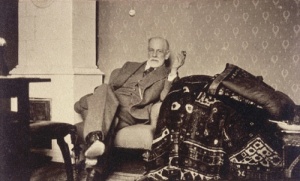The horror of TESL
If any kind of self-reflexivity indexes the most primitive form of professionalism in a particular walk of life, then a hapless self-reflexivity is undoubtedly the hallmark of a mature profession. The wretched hand-wringing, the cries of ‘The horror! The horror!’, and a resigned dismalness all signify an acknowledgement of the abyss that lies at the heart of every profession: we know now how little we know and quite how useless we are.
Anyone with any familiarity of quite how arbitrarily English is learnt will no doubt understand that ESL teachers daily stare into the heart of darkness, acknowledging it with a practised incantation of grammatical runes. We know they don’t work but somehow we keep chanting them anyway, partly to keep the darkness away, partly perhaps to minister to the needs of DoS Kurtz.
Still, however heartbreaking the knowledge may be that our profession is based on a lack of understanding of how we teach, at least we know what we are teaching. We have that to hang onto. Or at least we did….
The singularity of TESL
Futurists, such as Ray Kurzweil and John Smart, have long predicted that sometime in this century humanity will experience or face a technological singularity. The Singularity, as it is called in these hallowed circles, is usually regarded as the point at which technological advances exceed our understanding, and when some form of artificial intelligence takes over responsibility for designing its own progeny. The brood of A.I.s can be expected to develop far more rapidly than we can imagine and will, with the aid of other technologies, alter the very nature of existence.
In another age, this is what Hegel modestly called the night of the world, when an entire symbolic system is ransacked and in its stead comes a whole new way of looking at the world that is so fundamental it changes the world itself. Whether this future world requires humans, let alone ESL teachers, is a matter of awkward speculation and some panic at the moment. However, it does lead me to wonder what constitutes TESL’s night of the world.
Most professions have, at one stage or another, experienced a kind of intra-disciplinary singularity, the point after which nothing was the same again. Quantum mechanics stands out as a clear instance of singularity in the life of physicists, but there are many more mundane versions. In advertising, for example, when Bill Bernbach started making adverts in the 1960s, he inaugurated an era of stylish and witty copy that fundamentally changed the Ogilivy-inspired generation of ad-men forever.
Looking at the history of TESL, from Berlitz to Dogme, I am inclined to think that it is actually a profession marked by a continuity of singularities, rather than a continuity interrupted by a lone singularity. However, while seemingly radical, all of these changes in methodology function within a grammar-lexis continuum which presupposes that what is taught, i.e. the English language, is the sine qua non of the profession. Any kind of singularity in TESL would therefore be one in which this is no longer the case.
Post-TESL
Enter David Graddol with the single most important publication of the last decade: English Next. With this small book, Graddol delivered a big blow to TESL. Using Kuhn’s rather more conservative-sounding notion of a paradigm shift, Graddol takes the last leg from under the profession of TESL by announcing that there is no longer any need to teach English. Simply, and effectively, this is because English no longer exists.
Indeed, in the dawn after the night of the world, English, World Standard English that is, is no longer a language as such – it’s a function-delivery system. Pared down to a minimum grammar, a utilitarian lexis and a phonology redolent of the average grunting range of a teenager, it barely meets the criteria for a rich and complex language. Rather, it’s what you use to negotiate a business deal, secure a hotel booking or understand the instruction leaflet with your rocket launcher. In the case of CLIL, it’s what you employ to pass your chemistry exam. As with all things designed purely to fulfil a function, it’s essentially a joyless affair.
The long goodbye
By way of an optimistic counterpoint, it might be useful to paraphrase Raymond Chandler here. He proposed that when we read a detective story, a story that is largely valued for its plot, it is not the story we like, even if we think it is. Rather, it is the way the city backdrop is described in the summer heat, the way the moods of the detective express themselves in drinking binges, or the way the murder victim is hunched over a chess problem just before he is killed. That is to say, we often value something which seems utilitarian for reasons other than its utility. I suspect learning English has its own accidental motivations, some of which I touched on in a previous post, and few of which are deducible to focus groups which prompt an instrumental response.
All of which leads me to a rather more sanguine scenario for TESL after its Graddolization. Happier, shiner times lie ahead for some of us. The bulk and the blubber of TESL will disappear every bit as efficiently as a whale carcass on the Pequod with large chunks of the current system being carved up for state or local institutions to teach WSE. This part of the ESL industry will principally be the preserve of reluctant teenagers who have no choice in what they study and, given the limitations of WSE, even less interest. English for Special Purposes will no doubt thrive too, offering in its particularity an interesting foil to the dull ecumenicalism of WSE.
And then, somewhere, there will be learners, guided by cultural, political and psychological compunctions that seek expression outwith the coarser rubric of WSE, who want to study the arthritic progenitors of WSE, such as now quaintly and briefly dominate course books qua natural English. For these strange creatures, the various native Englishes are a delight unto themselves and, as such, worthy of patient study. To serve them, a dwindling band of ESL teachers will remain, shorn of the dilettantes, but infused with a more cogent professionalism, passion and pride than the current system fosters. At least that’s what I promise myself.



